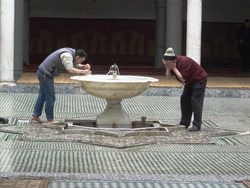
Know what to see, what to visit and what to do when traveling to Fez
Fez, historic city, melting pot of cultures, labyrinth of legends, mosaic of handicrafts, indigo sky and pink afternoon, and floating in the air, the notes of the Mohecin song, calling from one of its hundreds of mosques to prayer.

Few cities remain in the world that retain a character as medieval as Fez. Visiting Fez is like traveling through time, like opening a door and entering the setting of an oriental tale.
Information about Fez
Fez is still one of the imperial cities, in fact the first, since its foundation dating from the ninth century, and symbol of this capital, is its marvelous royal palace, Dar el Makhzen, which from the 14th century houses the royal family Alahuí , Descendants of the prophet and monarchs of Morocco. The majestic bronze doors, the preciousness of its tiles in green and blue tones, the walls and filigree of its plasterwork, leave no visitor immune, making us dream of what we can not see, imagining sumptuous halls, gardens of Eden, Marble fountains dotted with rose petals, holy stick furniture, mahogany and cedar, and ivory, malachite, gold, and precious stones.
Near The Royal Palace of Fez lies the Jewish quarter, the well-known Mellah (this word means salt, which was formerly used as a means of payment, hence the origin of the word salary, since it was probably the Jews who had the Monopoly of this appreciated condiment). Many of the original inhabitants of this neighborhood were the Sephardic Jews, who fled Spain after the edict of expulsion of the Catholic Monarchs, and who had to organize the diaspora towards Portugal and Morocco, leaving their imprint and traditions forever in the annals Of some cities like Fez, Rabat, Tangier, etc.
However, if there is one element that defines Fez, it is his medina, in the part that we know as Fez the Bali. World Heritage since 1981, it is the largest medina in the world. In it we find architectural jewels, such as the Andalusian Mosque or the 9th century Mezqita Qaraouiyin, the Medersa Bou Inania and Attarine, the gates of Bab Boujloud, or the Nejjarine and Seffarine squares. But if there is something surprising in the medina of Fez is its inexhaustible display of various trades, many of them already lost in the Western world. In the medina of Fez we will find forgers, potters, blacksmiths, dyers, tanners, tailors, spinners, charcoal makers, bakers, each in his neighborhood and in a defined place of the medina, since this is organized by guilds, as in The average age. We can not forget your typical means of transport in the medina, donkeys, loaded with various goods enter and leave the medina to the cry of "Balak", which means care, and that impels us to stick to the wall not to be rolled up In the narrowness of its winding alleys.
The tourists and foreigners are mixed in their alleys, squares and adarves, and are not surprised by the infinite wealth that in every corner of the medina find, by the idiosyncrasy of these kind people, by the mixture of smells and colors that define Made like that city of the thousand and one nights that evokes our memory.























